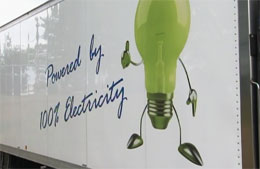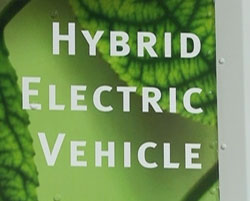Hybrid Fleets
By now, nearly every major carmaker has jumped onto the hybrid-electric-drive bandwagon. Light duty hybrids can be found in every parking lot in America, while full-electrics, fuel cells and plug-ins are inching closer to the mainstream. All of these technologies will help reduce our need for imported petroleum. But the benefits of hybrid and electric power trains are not limited to personal-use vehicles. Indeed, some of the most innovative technology is being developed on a much larger scale.
Although medium and heavy-duty trucks and buses account for just 4 percent of the traffic on U.S. Highways, they consume a disproportionate 22 percent of our transportation fuel and produce 20 percent of all vehicle-based carbon emissions. Well, that’s about to change. New government regulations are requiring big rigs to clean up their act. Up to a 20 percent reduction in greenhouse gas emissions and a corresponding gain in fuel economy by model year 2018.
 New heavy duty pickups and vans must improve by 15 percent, and so-called vocational vehicles: delivery trucks, buses and refuse vehicles, will have 10 percent targets for improvement. Those goals can mostly be achieved with systematic use of off-the shelf technology such as idle reduction, aerodynamics, tires, and engine control systems. But the phenomenal rise of efficient hybrid and electric passenger cars in recent years has more and more truck fleets looking to plug in to that successful formula right now.
New heavy duty pickups and vans must improve by 15 percent, and so-called vocational vehicles: delivery trucks, buses and refuse vehicles, will have 10 percent targets for improvement. Those goals can mostly be achieved with systematic use of off-the shelf technology such as idle reduction, aerodynamics, tires, and engine control systems. But the phenomenal rise of efficient hybrid and electric passenger cars in recent years has more and more truck fleets looking to plug in to that successful formula right now.
JOHN BOESEL: And what we’re seeing is a tremendous segmentation of the truck market. In the smaller, light-duty lighter trucks like UPS and FedEx, I think there’s a growing interest in electric trucks and then in the heavier trucks you’re seeing more interest in hybrid. So, Coca-Cola has now more than 700 hybrid trucks on the road, and they carry a lot of weight, a lot of beverage, and they’re finding that the hybrid technology really works well and there’s a good payoff for that technology.
JOHN DAVIS: Most heavy hybrids now are diesel powered, but it’s important to know that hybrid technology is fuel-neutral and many cleaner variants are available: delivery trucks are subjected to a rigorous daily regimen of stops and starts, long periods of waiting, and varying load conditions, making them ideal candidates for the use of quiet, high-torque electric motors. UPS has one of the largest private clean fleets in the world. Their 2200 alternative-fueled vehicles have traveled more than 200 million miles in the past decade. Most recently, UPS has ordered 100 EVI all-electric delivery trucks for short-range urban routes in California. The trucks have a 90-mile operating range and will displace 126,000 gallons of diesel per year.
The Lee’s Summit school R-7 district in Missouri is hoping their small town can make a big difference with these Smith all-electric delivery trucks.
 RON COX: One of the things we want to do is be a moving billboard in around these school zones for these kids, for our teachers, for our community. They look at it and see this is an alternative fuel project: it’s cleaner, it’s greener, it’s safer, and it’s the way we need to go. And so, we’re proud of that and we want to advertise that for public information.
RON COX: One of the things we want to do is be a moving billboard in around these school zones for these kids, for our teachers, for our community. They look at it and see this is an alternative fuel project: it’s cleaner, it’s greener, it’s safer, and it’s the way we need to go. And so, we’re proud of that and we want to advertise that for public information.
JOHN DAVIS: Likewise, there is promise in applying hybrid drive to the 75,000 or so refuse trucks that roam our nation’s neighborhoods every morning. Hundreds of cities from San Francisco to New York are investing in hybrid transit and school buses. This Wisconsin school district has a fleet of plug-in diesel hybrid buses but uses solar power to recharge them.
Denver’s RTD downtown shuttle fleet is made up of 36 hybrid buses that they have converted from diesel to compressed natural gas. This is seen by many as the best evolution of heavy hybrid fleets. The potential of hybrid and electric vehicles for commercial use is sky high. But, the reality is that new technology always costs more to implement than sticking with the tried and true. In some states, there are local grants and incentives available to offset this premium, but rising fuel costs and other factors are quickly making the electric switch a more viable option, even at face value.
 The deployment of more efficient cleaner technologies for medium and heavy duty trucks can also help America’s industrial sector. Domestic companies are leading the way in developing heavy-duty hybrid and electric platforms, idle reduction and other technologies that will soon be in demand worldwide. Lessons learned now will pay big dividends later, and form the bridge to a cleaner, secure keep on truckin’ future.
The deployment of more efficient cleaner technologies for medium and heavy duty trucks can also help America’s industrial sector. Domestic companies are leading the way in developing heavy-duty hybrid and electric platforms, idle reduction and other technologies that will soon be in demand worldwide. Lessons learned now will pay big dividends later, and form the bridge to a cleaner, secure keep on truckin’ future.






